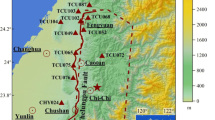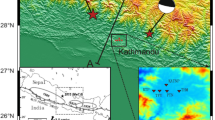Abstract
In this paper, near-fault strong ground motions caused by a surface rupture fault (SRF) and a buried fault (BF) are numerically simulated and compared by using a time-space-decoupled, explicit finite element method combined with a multi-transmitting formula (MTF) of an artificial boundary. Prior to the comparison, verification of the explicit element method and the MTF is conducted. The comparison results show that the final dislocation of the SRF is larger than the BF for the same stress drop on the fault plane. The maximum final dislocation occurs on the fault upper line for the SRF; however, for the BF, the maximum final dislocation is located on the fault central part. Meanwhile, the PGA, PGV and PGD of long period ground motions (≤1 Hz) generated by the SRF are much higher than those of the BF in the near-fault region. The peak value of the velocity pulse generated by the SRF is also higher than the BF. Furthermore, it is found that in a very narrow region along the fault trace, ground motions caused by the SRF are much higher than by the BF. These results may explain why SRFs almost always cause heavy damage in near-fault regions compared to buried faults.
Similar content being viewed by others
References
Barka AHS (2001), “The Surface Rupture and Slip Distribution of the August 17, 1999 Izmit Earthquake, M 7.4, North Anatolian Fault,” Bull, Seism. Soc. Am, 92: 43–60.
BRI(1996), “Final Report on the 1995 Hyogo-ken Nanbu earthquake,” Vol 1. (in Japnese)
Dahel FA (1974), “On the Ratio of P-wave to S-wave Corner Frequencies for Shallow Earthquake Sources,” Bull. Seism. Soc. Am., 64: 1159–1180.
Dalguer L, AK Irikura, JD Riera and HC Chiu (2001), “Importance of the Dynamic Source on Strong Ground Motion During the 1999 Chi-Chi, Taiwan, Earthquake: Brief Interpretation of the Damage Distribution on Buildings,” Bull. Seism. Soc. Am., 91: 1112–1127.
Inoue T and T Miyatake (1998), “3D Simulation of Near-Field Ground Motion Based on Dynamic Modeling,” Bull, Seism.Soc.Am., 88: 1445–1456.
Kostrov BV (1964), “Self-similar Problems of Propagation of Shear Cracks,” J. Appl. Math. Mech., 28: 1077–1087.
Liao ZP (1996), “Normal Transmitting Boundary Condition,” Science in China, Series E, 39(3), 244–251.
Liao ZP (1998), The Decoupling Numerical Simulation of Wave Motion, in Dynamic Soil-structure Interaction (ed. Zhang, CH, Wolf JP), Amsterdam, pp. 125–140.
Miyatake T (1980), “Numerical Simulation of Earthquake Source Process by a Three-dimensional Crack Model, Part I, Rupture Process,” J. Phys. Earth., 28: 565–598.
Olsen K, R Madaraga and R Archuleta (1997), “Three Dimensional Dynamic Simulation of the 1992 Landers Earthquake,” Science, 278: 834–838
Shin TC and TengTa-liang (2001), “An Overview of the 1999 Chi-chi, Taiwan Earthquake,” Bull. Seism. Soc. Am., 91: 895–913.
Author information
Authors and Affiliations
Corresponding author
Additional information
Supported by: National Natural Science Foundation of China Under Grant No. 50408003; National Scientific and Technical Supporting Programs Funded by Ministry of Science & Technology of China Under Grant No. 2006BAC13B01
Rights and permissions
About this article
Cite this article
Liu, Q., Yuan, Y. & Jin, X. 3D simulation of near-fault strong ground motion: comparison between surface rupture fault and buried fault. Earthq. Eng. Eng. Vib. 6, 337–344 (2007). https://doi.org/10.1007/s11803-007-0753-z
Received:
Accepted:
Issue Date:
DOI: https://doi.org/10.1007/s11803-007-0753-z




